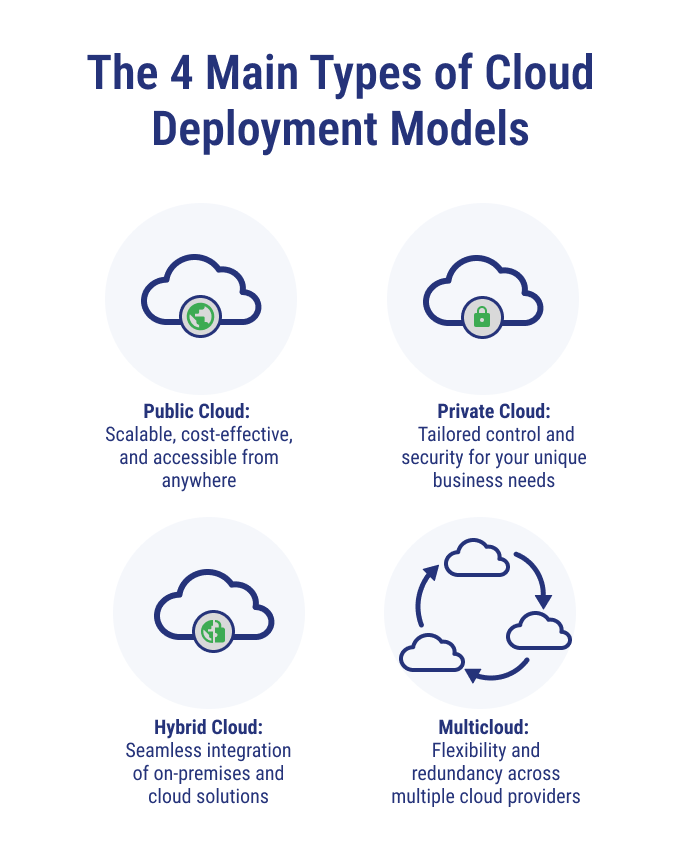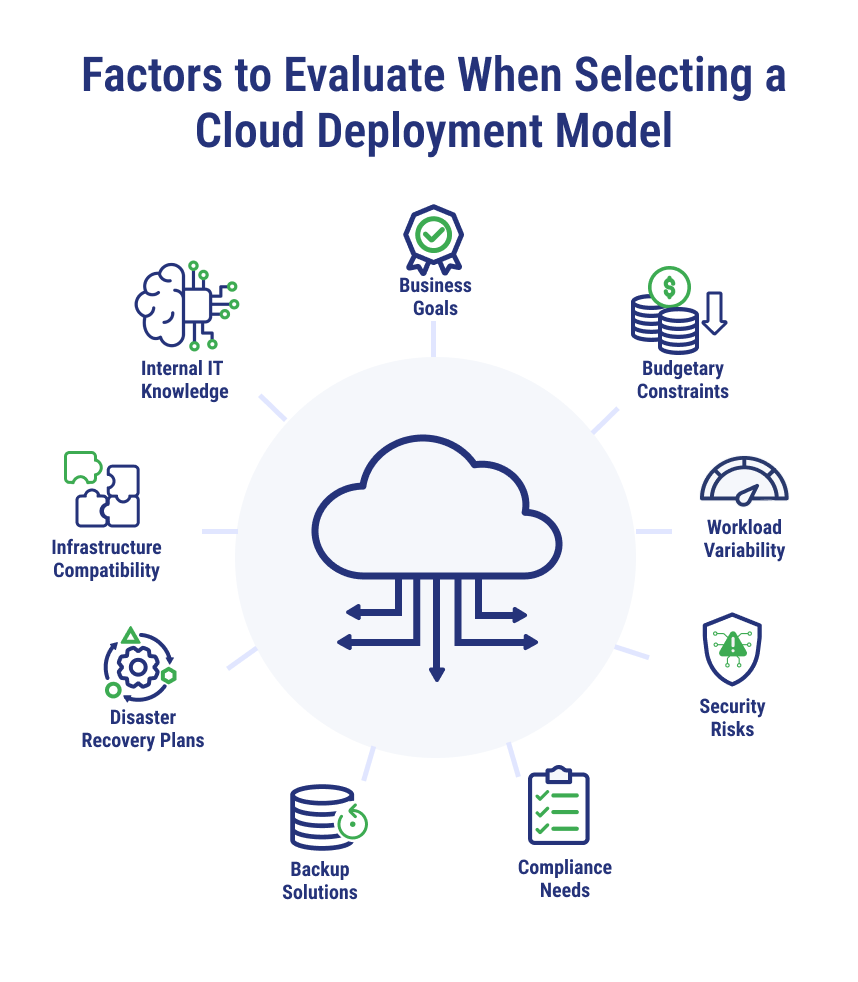
Migrating to the cloud, or adding a new cloud environment, can help businesses exceed the capabilities of their current legacy systems. However, not all cloud deployments offer the same features, benefits, and prices. It’s important that businesses evaluate different cloud deployment models before committing to a migration plan. We’ll cover different types of cloud computing deployment models, the benefits and challenges of each, and use cases to help you think through what might work best for your business.
What Are Cloud Deployment Models?
Cloud deployment models encompass the different ways that cloud models can be set up and utilized. Businesses have a choice between several different models during cloud adoption, each of which comes with its own benefits and drawbacks. To find one that matches their goals, businesses need to consider the implications of scalability, security, and flexibility in different cloud deployment models.
What Are the Main Types of Cloud Deployment Models?
There are four main types of cloud deployment models: public, private, hybrid, and multicloud.

The Public Cloud Deployment Model
In a public cloud model, businesses share cloud resources from a cloud service provider (CSP) such as Microsoft Azure, Amazon Web Services (AWS), or Google Cloud Platform (GCP). While public cloud providers offer the same basic suite of services, it’s important to understand the strength of their capabilities and pricing models to decide which vendor is right for your needs.
Benefits of Public Cloud
Public cloud computing is highly scalable, flexible, and cost-effective. Most businesses will purchase cloud resources using a pay-as-you-go method, making the deployment model ideal for fluctuating or unpredictable workloads.
Challenges of Public Cloud
While public cloud platforms are generally secure, businesses must be aware of the shared responsibility model, leaving providers certain security responsibilities while leaving the others up to customers. Organizations that rely on one cloud provider may also experience a feeling of vendor lock-in, where they can’t easily exchange the tools and services of one vendor for another.
The Private Cloud Deployment Model
With the private cloud model, infrastructure is dedicated to one organization. This deployment model can be hosted on-premises by a business or via a third-party managed data center.
The Public Cloud Deployment Model
In a public cloud model, businesses share cloud resources from a cloud service provider (CSP) such as Microsoft Azure, Amazon Web Services (AWS), or Google Cloud Platform (GCP). While public cloud providers offer the same basic suite of services, it’s important to understand the strength of their capabilities and pricing models to decide which vendor is right for your needs.
Benefits of Public Cloud
Public cloud computing is highly scalable, flexible, and cost-effective. Most businesses will purchase cloud resources using a pay-as-you-go method, making the deployment model ideal for fluctuating or unpredictable workloads.
Challenges of Public Cloud
While public cloud platforms are generally secure, businesses must be aware of the shared responsibility model, leaving providers certain security responsibilities while leaving the others up to customers. Organizations that rely on one cloud provider may also experience a feeling of vendor lock-in, where they can’t easily exchange the tools and services of one vendor for another.
The Private Cloud Deployment Model
With the private cloud model, infrastructure is dedicated to one organization. This deployment model can be hosted on-premises by a business or via a third-party managed data center.
The Multicloud Deployment Model
Multicloud is similar to hybrid cloud—the difference is that this model consists of more than one public cloud. A multicloud configuration can be used to support different workloads or different regions, for example.
Benefits of Multicloud
Utilizing more than one public cloud means your environment is more resilient, decreasing the likelihood of outages and business disruptions. Vendor lock-in is also less likely when organizations rely on multiple cloud providers. Because businesses have the ability to choose the best cloud provider for the best workload, they can benefit greatly from the increased flexibility.
Challenges of Multicloud
Much like hybrid cloud, managing multiple environments can get complicated, and optimizing the total cost of ownership (TCO) can also be a challenge with more choices available.
Use Cases for Different Cloud Deployment Models
Which cloud deployment model works for which company will depend on many factors—including specific application performance requirements, security and compliance considerations, and cost management strategies for maximizing resource efficiency and redundancy. Here are a few examples of use cases for each deployment model.
Public Cloud Use Case
Manufacturing companies grow and change their products over time to meet the evolving needs of customers. Public cloud is designed to accomplish the same thing. A manufacturing company came to TierPoint looking for an evolution-friendly answer to their legacy systems, which resulted in an Azure migration and a much more flexible IT environment.
Private Cloud Use Case
Healthcare organizations deal with massive amounts of sensitive data. Personally identifiable health information could be dangerous in the wrong hands. Private cloud offers a higher level of security and compliance with regulations such as HIPAA compared to a public cloud deployment.
Hybrid Cloud Use Case
In some industries, a split between flexibility and security will lead to hybrid cloud deployments being the most fitting option. Sometimes, hybrid cloud becomes an option because there is a need to migrate legacy systems to an environment with more customizations than what public cloud deployments offer. A unique case we encountered was with an energy trading company experiencing a divestment and requiring a managed hybrid solution moving forward.
Multicloud Use Case
Multicloud deployments can work well for companies that don’t need the level of compliance and security offered by private cloud but are looking for more redundancies. Companies that operate in multiple countries or regions could use a multicloud environment for greater geographical diversity in workloads.
How Do You Start Evaluating Cloud Deployment Models?
When it’s time to start evaluating cloud deployment models, consider the following questions and factors to make your decisions.

What Are Your Business Objectives?
Your business objectives will greatly impact the cloud deployment model you choose. For example, if scalability and flexibility are important to you to accommodate future growth and changing business needs, private cloud may not be the most appealing model.
Do You Have Budget Constraints?
If you’re unable to shoulder the one-time costs of private cloud and don’t want to be tasked with ongoing management costs of private cloud, a public cloud model may be more budget friendly. However, if you already own equipment or think you may use purchased equipment for several years, private cloud may be easier on your wallet.
How Do Your Workloads Vary?
For steady workloads, organizations can choose reserved instances in public cloud deployments or feel comfortable with set private cloud sizes. Variable workloads can be better served by public cloud, multicloud, and hybrid cloud.
What Level of Control and Security Do You Need?
If you need greater control and security, private cloud is often the way to go. However, if a public cloud provider meets the compliance standards you need and has the security controls you’re looking for, it may be an appropriate deployment model.
How Does the Deployment Model Enhance Your Disaster Recovery Strategy?
Different deployment models are capable of different levels of disaster recovery. For example, a deployment that includes multiple environments, such as multicloud, can distribute workloads across providers and offer the redundancy necessary to help businesses achieve their recovery time objectives (RTO) and recovery point objectives (RPO).
What Backup Solutions Are Available Within Each Model?
Snapshots, archives, and backups are all different types of backup solutions available with different cloud deployment models. What you need will depend on how much data loss you can handle and how quickly you need to restore or access data after an outage.
What Are Your Compliance and Regulatory Requirements?
Cloud providers can meet the most common regulatory requirements, but if compliance is a more complicated road, it may be best to choose a private cloud deployment model.
Is Your Current IT Infrastructure Compatible?
How much work will you need to undergo to get your current IT infrastructure connected or migrated to your desired cloud deployment model? Consider the connectivity, data migration capability, and security protocols that may need to be changed or tweaked to work properly.
Does Your Team Have the Right Cloud Knowledge?
Finally, does your team have the expertise necessary to work within this new cloud deployment model? If they don’t have the right skills, it may be beneficial to hire a third-party cloud expert or invest in training for the internal IT team.
Choosing the Right Cloud Deployment Model
The right cloud deployment model will be the one that matches the combination of needs your business is looking to satisfy. Each one comes with its own benefits and challenges, and navigating the vendor and provider landscape requires time and skill. TierPoint’s IT advisory consulting services can reduce the effort associated with searching for the right cloud deployment model.
Download our whitepaper on how to integrate Microsoft Azure and Azure Stack to help your business unlock the full potential of hybrid cloud.

